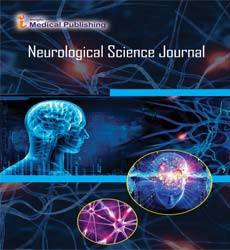A Neurological Aspect of Mental Disorder and its Therapy Prospectus
Alex Brune*
Department of Psychiatry,University of Bocuhm, Bochum, Germany
- *Corresponding Author:
- Alex Brune
Department of Psychiatry,
University of Ruhr Bochum,
Bochum,
Germany,
E-mail: brune.21alex@edu.de
Received Date: August 06, 2021 Accepted Date: August 20, 2021 Published Date: August 27, 2021
Citation: Brune A (2021) A Neurological Aspect of Mental Disorder and its Therapy Prospectus. Neurol Sci J Vol. 5 No. 4:4
Description
For a long time, psyche and cerebrum were viewed as particular elements. Innovation and the improvement of neuroscience as a discipline have since prompted the rise of another origination of psyche as the aftereffect of cycles happening in the mind. Localizations hypotheses contended that each piece of the mind is liable for a particular capacity; as indicated by this view, a limited cerebrum injury would specifically harm certain intellectual cycles. In any case, these cerebrum maps bar many capacities that have traditionally been ascribed to the idea of psyche: Conduct, character, disposition, and influence, among others. Moving past the localizations approach, the cerebrum was perceived to work through perplexing, interconnected circuits including both the cerebral cortex and the white matter. In any case, a very long while passed before the disclosure would be made that the mind has this ability, but at the same time can frame new nerve cells. This commentary audits a few parts of cerebrum infection and how it is connected with network and pliancy, just as the major parts of intellectual treatment methods dependent on these capacities. The human cerebrum is a mind boggling organization of fundamentally and practically interconnected districts; mind work emerges from the arranged association of the organ in general. Cerebrum injuries can accordingly cause practical shortfalls through fundamental components: nearby cortical brokenness in the influenced locale, and spatially separate brokenness brought about by interference of the association between two regions.
Investigation into the circuits and organizations comprising the exceptionally perplexing association of the cerebrum permits us more noteworthy knowledge into the organizing of the greater intellectual capacities and their inclusion in different neurological illnesses. In reality, we currently realize that the shortfalls related with so many problems as Alzheimer infection, various sclerosis, schizophrenia, Traumatic Brain Injury (TBI), depression, autism and so forth, are joined by mind network changes.
In Alzheimer illness, we notice decreased thickness of dendritic spines in cortical pyramidal cells and primary adjustments to inhibitory circuits; this prompts a separation between various areas of the cerebrum, for example, the back cingulate and the hippocampus. These progressions can be recognized in the prodromal phase of the sickness, and are connected with the level of intellectual disability in later stages.
Both intellectual shortages and enthusiastic and conduct modifications have been related with the interference of cerebrum networks in patients with various sclerosis; utilitarian neuroimaging studies have additionally shown adjustments in mind actuation and practical availability designs.
Adjusted synchronization has likewise been depicted in different mind networks in patients with mental imbalance range problems. This has been affirmed by a few functional Magnetic Resonance Imaging (fMRI) considers. In any case, different investigations have likewise discovered proof of this utilitarian network adjustment in patients with mental imbalance who were very still.
Traumatic brain injury likewise includes the interference of cerebrum organizations, which causes extensive intellectual and social problems. The diffuse axonal harm brought about by such an injury influences white matter plots associating the hubs of broadly dispersed neural organizations. This new availability based methodology brings better approaches for understanding the systems hidden the deficiencies that seem following cerebrum injury and the progressions to network that happen during recuperation.
The incredible benefits of the cerebrum's organization based working are the subsequent pliancy and impermanence. Plasticity is communicated in shifting structures in mind wounds, going from utilitarian adjustments of existing designs to the development and expansion of new constructions and neurons. Thusly, the cerebrum looks for methods of fixing itself, starting a course of regenerative occasions by making neurotransmitters (synaptogenesis) in perilesional regions and neurons (neurogenesis) in the sub granular zone of the dentate gyrus and the sub ventricular zone. Plasticity components are set off right now of cerebrum injury, empowering some measure of unconstrained recuperation and fix. Cognitive therapy follows up on the changes that happen following cerebrum injury, with the end goal of reestablishing or making up for the harmed work to work on the patient's capacities and advance reincorporation into work and ordinary exercises.
The cerebrum capacities comprehensively through a broad organization of circuits which are answerable for all sensorimotor, vegetative, and mental cycles. Comprehension of the cerebrum's availability and versatility offers another viewpoint from which to move toward mind working and illness and the maintenance and recuperation systems that establish the premise of intellectual and conduct treatment.
Open Access Journals
- Aquaculture & Veterinary Science
- Chemistry & Chemical Sciences
- Clinical Sciences
- Engineering
- General Science
- Genetics & Molecular Biology
- Health Care & Nursing
- Immunology & Microbiology
- Materials Science
- Mathematics & Physics
- Medical Sciences
- Neurology & Psychiatry
- Oncology & Cancer Science
- Pharmaceutical Sciences
